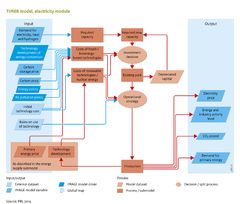Energy conversion: Difference between revisions
Jump to navigation
Jump to search
No edit summary |
No edit summary |
||
| Line 11: | Line 11: | ||
<div class="version changev31"> | <div class="version changev31"> | ||
The energy conversion module of TIMER simulates the choices of input energy carriers in two steps. In the first step, investment decisions are made on the future generation mix in terms of newly added capital. In the second step, the actual use of the capacity in place depends on a set of model rules that determine how frequently the different types of power plants are used. The discussion focuses on the production of electricity and hydrogen. Other conversion processes have only | The energy conversion module of TIMER simulates the choices of input energy carriers in two steps. In the first step, investment decisions are made on the future generation mix in terms of newly added capital. In the second step, the actual use of the capacity in place depends on a set of model rules that determine how frequently the different types of power plants are used. The discussion focuses on the production of electricity and hydrogen. Other conversion processes have only been implemented in the model by simple multipliers, as they mostly convert energy from a single primary source to one secondary energy carrier. These processes are discussed in [[Energy supply]]. | ||
</div> | </div> | ||
|ComponentCode=EC | |ComponentCode=EC | ||
Revision as of 14:50, 6 November 2016
Parts of Energy conversion
| Component is implemented in: |
|
| Related IMAGE components |
| Projects/Applications |
| Models/Databases |
| Key publications |
Key policy issues
- What is the potential role of energy conversion sector, particularly in power production, in achieving a more sustainable energy system?
- What are the potential roles of individual technologies, such as carbon capture and storage (CCS), nuclear power, hydrogen and renewable energy?
